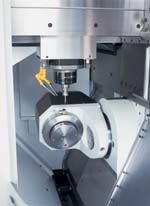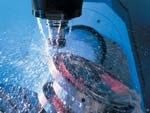High Speed In Simultaneous Five-Axis Machining
In mold and die work, simultaneous five-axis machining is a proven technology, as is high speed machining (HSM). High speed simultaneous five-axis machining, however, is still a pioneering development.
Share





In mold and die work, simultaneous five-axis machining is a proven technology, as is high speed machining (HSM). High speed simultaneous five-axis machining, however, is still a pioneering development. Machine tool builder Mikron (headquarters in Biel, Switzerland, with Mikron Bostomatic in Milford, Massachusetts, as its U.S. arm) has made a major thrust into this frontier with its new HSM 400 U machining center. The company is calling it the first machine capable of five-axis simultaneous machining in a "truly high speed mode." The breakthrough, the company claims, is in the design of its rotational axes. The axes, which tilt and swivel the workpiece under the main spindle head, have the speed and acceleration to match that of the X, Y and Z axes.
Three-axis high speed machining allows a small diameter tool to remove even hardened material efficiently by taking light cuts at high feed rates. However, small diameter tools cannot be very long because tool deflection soon diminishes dimensional accuracy. Short tools, although stiffer, create clearance problems, especially when trying to reach down low on the sidewalls of mold cores or male dies when the machine is limited to three axes. One way to overcome this limitation is to add the fourth and fifth axes so that the cutter can make moves at variable angles.
Unfortunately, conventional rotary axes either above the workpiece in the spindle head or below the workpiece in a rotary table usually lack the rigidity, positioning speed and acceleration rates necessary for HSM. Low rates of acceleration and deceleration have been an especially frustrating drawback when machining small details on molds and dies. Because the tool must change direction so often, the cutter rarely reaches the feed rates at which the main benefits of HSM kick in, so to speak.
The key for Mikron was designing and building rotary axes capable of speeds as high as 25 times those of conventional rotary tables. The HSM 400 U appears to have met this goal. The swiveling B axis has a range of ±110 degrees and is shown at one extreme of its range in the photo on page 60. It can swivel at a top speed of 150 rpm. The rotary C axis inside this swiveling head can rotate at 250 rpm. These axes are powered by liquid cooled direct drive motors, which can accelerate at 100 radians per second2 in B and 300 radians per second2 in C, or 10 times faster than previously possible, the builder claims. (For reference, the typical rotary table accelerates at 10 to 20 radians per second2.) High acceleration is required to maintain constant load on the cutter for the sake of tool life and surface finish.
The bed and column are built as a one-piece polymer concrete "portal" for stiffness and damping qualities. This design puts most of the machine's mass in non-moving parts, allowing the moving axes supported by this structure to have minimum mass. Heat sources associated with the linear axes can also be isolated. The X, Y and Z axes are equipped with high-end glass scales to ensure positional accuracy. Direct measurement systems are also used on the B and C axes. Five-axis machining puts intense computational demands on the control unit, so a high-end control unit is essential. In this case, the Heidenhain iTNC530 is offered.
Other important specs include a 25 kg weight limit on the workpiece; and X, Y and Z travels of 400 mm, 240 mm and 350 mm respectively. Built-in automation in the form of a 20-position pallet changer is standard. Wet or dry machining is possible, and the machine is highly suitable for milling graphite electrodes.The curved enclosure door can be opened with one hand to access both the front and side of the work zone.
Related Content
6 Machine Shop Essentials to Stay Competitive
If you want to streamline production and be competitive in the industry, you will need far more than a standard three-axis CNC mill or two-axis CNC lathe and a few measuring tools.
Read MoreInside a CNC-Machined Gothic Monastery in Wyoming
An inside look into the Carmelite Monks of Wyoming, who are combining centuries-old Gothic architectural principles with modern CNC machining to build a monastery in the mountains of Wyoming.
Read More5 Tips for Running a Profitable Aerospace Shop
Aerospace machining is a demanding and competitive sector of manufacturing, but this shop demonstrates five ways to find aerospace success.
Read MoreLean Approach to Automated Machine Tending Delivers Quicker Paths to Success
Almost any shop can automate at least some of its production, even in low-volume, high-mix applications. The key to getting started is finding the simplest solutions that fit your requirements. It helps to work with an automation partner that understands your needs.
Read MoreRead Next
Building Out a Foundation for Student Machinists
Autodesk and Haas have teamed up to produce an introductory course for students that covers the basics of CAD, CAM and CNC while providing them with a portfolio part.
Read MoreSetting Up the Building Blocks for a Digital Factory
Woodward Inc. spent over a year developing an API to connect machines to its digital factory. Caron Engineering’s MiConnect has cut most of this process while also granting the shop greater access to machine information.
Read More5 Rules of Thumb for Buying CNC Machine Tools
Use these tips to carefully plan your machine tool purchases and to avoid regretting your decision later.
Read More






















.jpg;maxWidth=300;quality=90)








